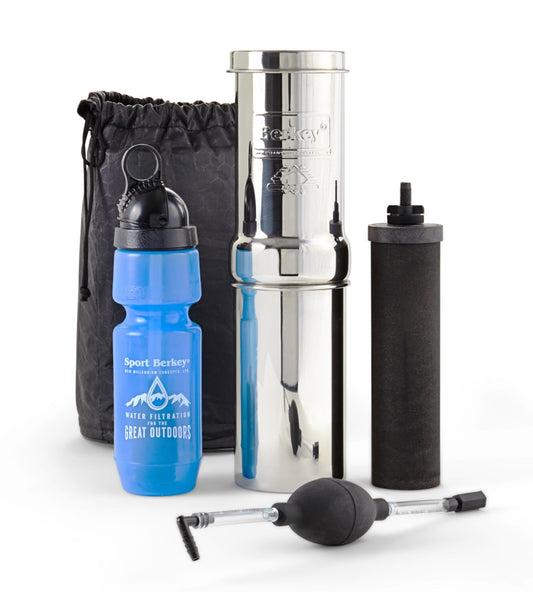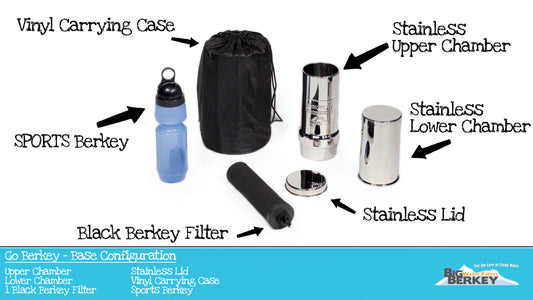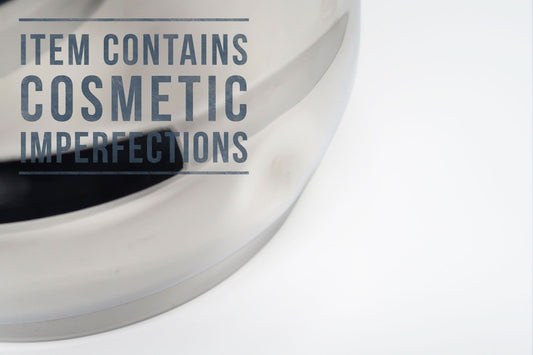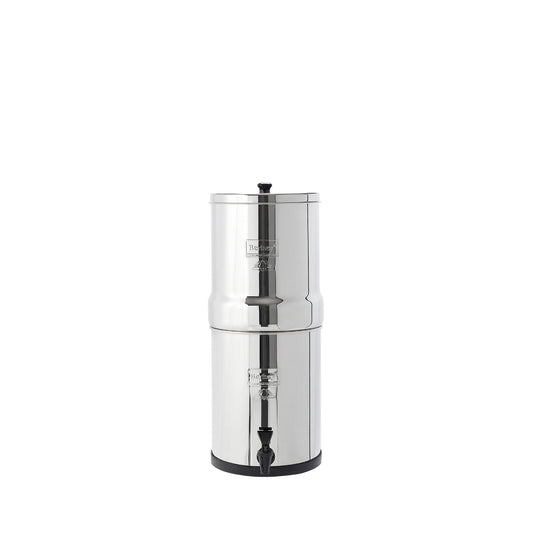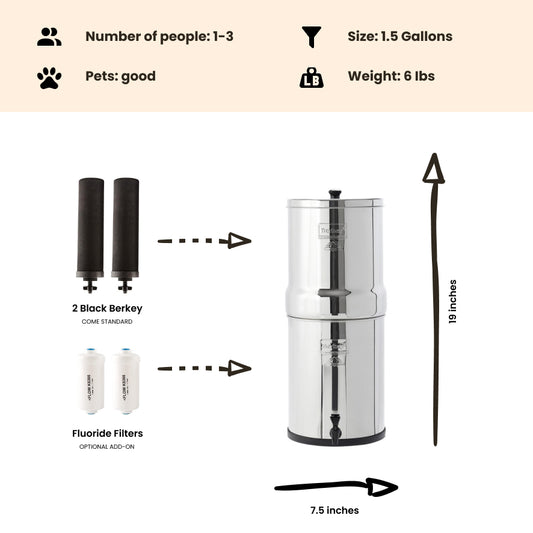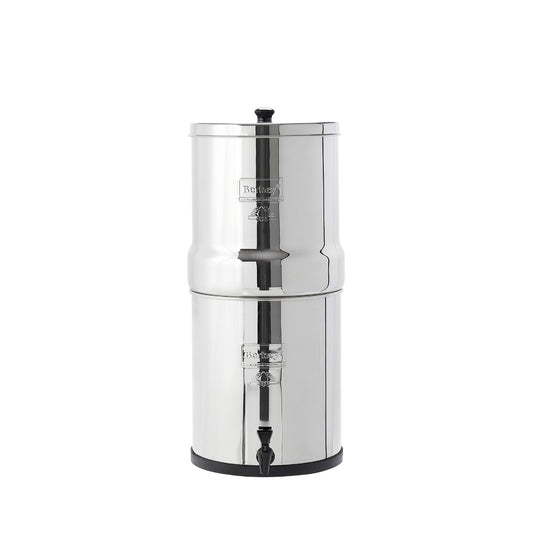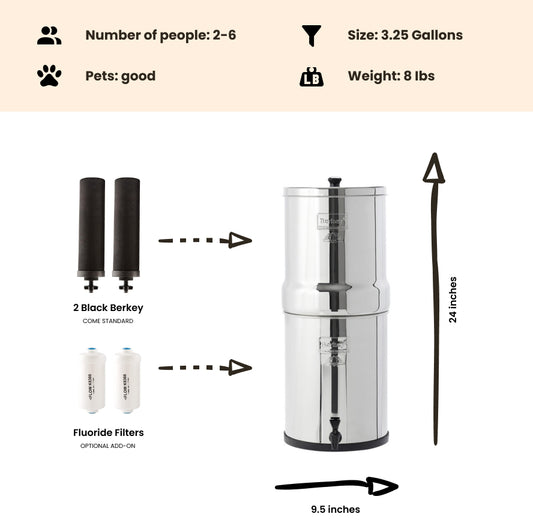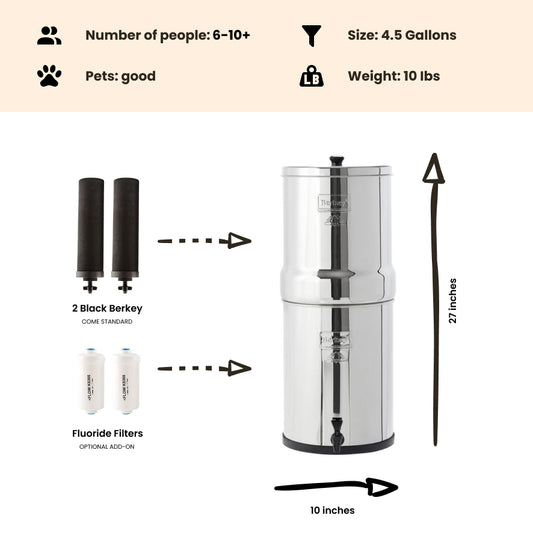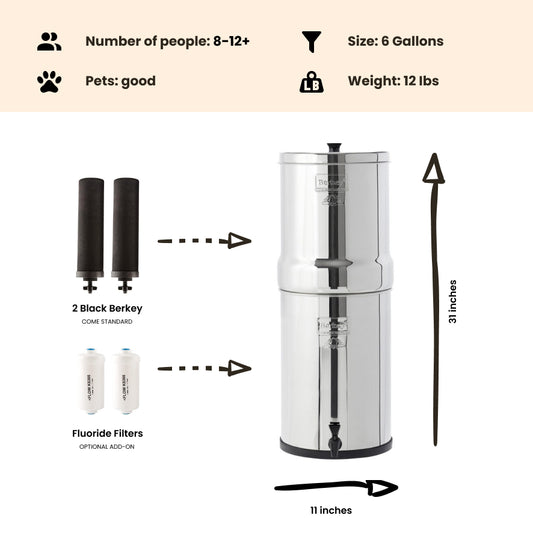
What is reverse osmosis water and how does RO work ?
By Dan DeBaunShare
Table of Contents: [hide]
- What is reverse osmosis water?
- How does a reverse osmosis system work?
- What are the stages of a reverse osmosis filter?
- What contaminants does reverse osmosis remove?
- What does reverse osmosis not remove?
- Is drinking reverse osmosis water good for you?
- What is the pH of reverse osmosis water?
- Should you add minerals back to reverse osmosis water?
- What are the common uses for reverse osmosis water?
- How does reverse osmosis compare to distilled water?
- What is the cost of a reverse osmosis system?
- How do you maintain a reverse osmosis system?
What is reverse osmosis water?
Reverse osmosis (RO) purifies water by using pressure to force tap water through a semi-permeable membrane. This advanced filtration method separates pure water from many impurities, as its microscopic pores allow water molecules to pass but block most dissolved solids, salts, and other contaminants.
The process splits the water into two streams: the purified "permeate" and a waste stream of rejected contaminants known as concentrate or brine. The final product is highly pure water with a much lower level of total dissolved solids (TDS).
How does a reverse osmosis system work?
A reverse osmosis (RO) system uses your home's water pressure to push water through a series of filters. The semi-permeable membrane is at its core. This process reverses the natural phenomenon of osmosis, forcing water against the membrane's microscopic pores. Pure water molecules pass through, but the membrane blocks larger particles like dissolved solids.
What are the stages of a reverse osmosis filter?
So, how does an RO system get your water so clean? Let's break it down. It's usually a three- to five-stage process:
- Pre-filtration: First, a sediment filter catches larger particles like dirt and rust. Then, a carbon pre-filter takes over, removing chlorine and chloramines, which protects the RO membrane from damage.
- Semi-permeable Membrane: In this critical step, the membrane removes nearly all dissolved solids and microscopic contaminants.
- Post-filtration: The final stage uses an activated carbon filter to polish the water, removing any residual tastes and odors before it reaches your glass.
What contaminants does reverse osmosis remove?
Reverse osmosis is effective because it targets a huge variety of contaminants. According to the U.S. Environmental Protection Agency (EPA), its semi-permeable membrane can remove up to 99% of them. RO is particularly effective at reducing total dissolved solids (TDS) by rejecting salts like sodium and chloride. It also removes other chemical and biological contaminants, including:
- Heavy metals (e.g., lead, arsenic, mercury)
- Fluoride
- Nitrates and sulfates
- Pesticides, VOCs, and PFAS
- Microplastics
- Most bacteria and viruses
What does reverse osmosis not remove?
Reverse osmosis is effective, but it doesn't remove everything. A standard RO system won't remove:
- Dissolved gases: An RO system doesn't remove substances like carbon dioxide, which can make the water slightly acidic and lower its pH.
- All bacteria and viruses: RO isn't a complete sterilization method. Bacteria can grow on the membrane (membrane fouling), often requiring additional UV disinfection.
- Beneficial minerals: The process strips away healthy minerals like calcium and magnesium.
- Certain chemical elements: The system doesn't effectively filter out some elements, such as boron.
Is drinking reverse osmosis water good for you?
Yes, drinking reverse osmosis water is safe, and its primary health benefit is its purity. The process removes many harmful contaminants like heavy metals, chemicals, and pesticides, which not only creates cleaner drinking water but also improves its taste and odor. Plus, using an RO system reduces plastic waste from bottled water.
However, there are potential concerns. This purification method also strips away beneficial minerals like calcium and magnesium, creating demineralized water with very low total dissolved solids (TDS) that can taste "flat." From my experience, this is the first thing people notice. The water can also be slightly acidic, with a pH between 6.0 and 6.5. While some worry about mineral deficiencies, reports from the World Health Organization show you get nearly all your essential minerals from food, not water, with water contributing only a small fraction. For most people, the purity of RO water is a clear benefit, though the wastewater produced by the system is another factor to consider.
What is the pH of reverse osmosis water?
Reverse osmosis (RO) water is typically slightly acidic, with a pH that usually ranges between 6.0 and 6.5. This happens because the purification process removes nearly all the dissolved minerals that act as natural pH buffers, causing the water's alkalinity to drop.
When this demineralized water comes into contact with air, it absorbs carbon dioxide (CO2). This forms a mild carbonic acid that lowers the pH, but while RO water is acidic, this isn't a major health concern. The human body easily maintains its internal pH balance, and many common foods are far more acidic.
Should you add minerals back to reverse osmosis water?
Some people improve their RO water through a process called remineralization, which aims to enhance taste, balance the pH, and reintroduce beneficial minerals.
RO water can taste "flat" since the process removes dissolved solids. Here's a little pro-tip: a remineralization filter adds back minerals like calcium and magnesium, restoring a more natural taste. Adding these alkaline minerals also neutralizes the water's slightly acidic pH, making it less corrosive. And while your diet provides most minerals, adding back electrolytes can put your mind at ease if you're worried about drinking demineralized water long-term.
What are the common uses for reverse osmosis water?
Thanks to its exceptional purity, reverse osmosis (RO) water is useful in many settings. At home, many people use it for drinking and cooking since its purity improves the taste of food, coffee, and tea. It's also great for making clear ice cubes and preventing mineral buildup in appliances like humidifiers.
In industrial settings that demand high purity, RO water is essential. Desalination plants use it to make drinking water from seawater, while power plants use it as boiler feed water to prevent corrosion. The food and beverage industry relies on it to concentrate whey or standardize water for drinks. Other commercial uses include professional window cleaning for a spot-free rinse and maintaining precise water chemistry in sensitive reef aquariums. Even more specialized uses include concentrating maple sap and producing hydrogen without mineral deposits on electrodes.
How does reverse osmosis compare to distilled water?
Both reverse osmosis and distilled water offer a high level of purity, but they're produced using very different methods. Reverse osmosis (RO) is a filtration process that uses pressure to force water through a membrane, blocking contaminants. Distillation mimics the natural water cycle by boiling water into steam and condensing it back into a pure liquid, leaving impurities behind.
While both methods are very effective at removing up to 99.9% of total dissolved solids (TDS), including heavy metals and salts, their main difference is mineral content. Distillation removes virtually all minerals, creating nearly pure H₂O.
RO systems are more energy-efficient and provide purified water on demand, making them practical for drinking. Distillation is a slower, more energy-intensive process. The total lack of minerals gives distilled water a "flat" taste, but its high purity is ideal for medical devices, labs, and car batteries where mineral deposits are a problem.
What is the cost of a reverse osmosis system?
The cost of a reverse osmosis (RO) system includes the initial purchase and long-term operation. An under-sink, countertop, or whole-house unit typically costs between $550 and $1,000 upfront. You should also plan for recurring maintenance, as the main ongoing expense is replacing the sediment, carbon, and RO membrane filters.
Several factors influence the final price tag. System efficiency determines the amount of wastewater, which can impact water bills. Additional features like a booster pump for low water pressure or a remineralization filter will also increase the price. Professional installation can add to the total expense as well.
How do you maintain a reverse osmosis system?
To get the best performance and longest life from your RO system, proper maintenance is essential. The main task is regular filter replacement. Pre-filters, including the sediment and carbon filters, usually need changing every 6 to 12 months. They remove particles and chlorine that can damage the delicate RO membrane. The membrane itself lasts longer, typically a year or more, depending on water quality and how often you change the pre-filters.
If you neglect filter changes, the system becomes less efficient and water quality suffers due to fouling and scaling. Trust me on this—it's the single most important thing you can do to protect your investment. The Centers for Disease Control and Prevention (CDC) also recommends you sanitize the entire system, including the storage tank, annually to prevent bacterial growth. Regularly check for leaks and ensure proper water pressure. Homes with low pressure might need a booster pump to keep the system working effectively.
Sources
-
Regular price $234.00 USDRegular priceUnit price / per
-
Regular price From $302.00 USDRegular priceUnit price / per
-
Regular price $327.00 USDRegular priceUnit price / per
-
Regular price From $367.00 USDRegular priceUnit price / per
-
Regular price From $408.00 USDRegular priceUnit price / per
-
Regular price From $451.00 USDRegular priceUnit price / per
-
Regular price From $478.00 USDRegular priceUnit price / per

Dan DeBaun
Dan DeBaun is the owner and operator of Big Berkey Water Filters. Prior to Berkey, Dan was an asset manager for a major telecommunications company. He graduated from Rutgers with an undergraduate degree in industrial engineering, followed by an MBA in finance from Rutgers as well. Dan enjoys biohacking, exercising, meditation, beach life, and spending time with family and friends.
~ The Owner of Big Berkey Water Filters

